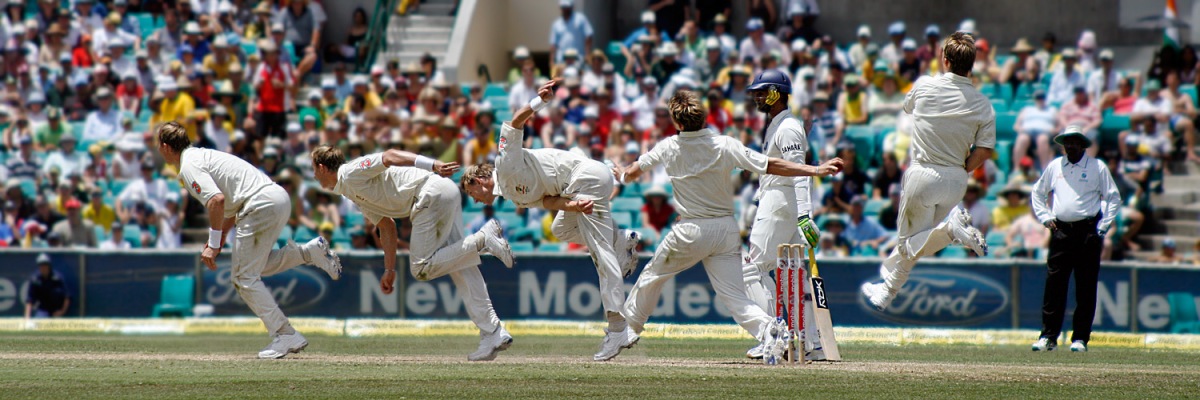
Following is a study of a paper that I found at quintec.com that does Bio-mechanical analysis.It is an attempt on understanding the technical aspects of fast bowling so that I can apply it in the near future on myself .
Fast Bowling Basics
This is how a typical or technically a side-on bowling looks like and the idea would be to develop my action as close to this one
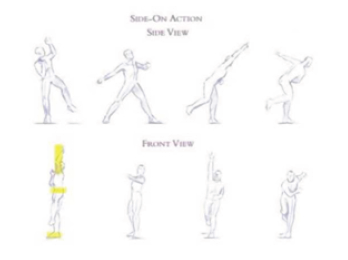
The study starts with the analysing the action from 3 different view Front-on , Back -on and Side-on. Bio-mechanical and technical analysis weree done for these in 6 different phases as shown in the image below
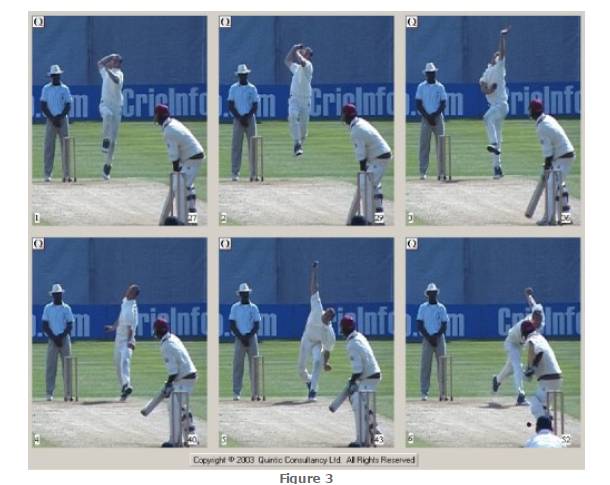
- Phase 1 : Pre-delivery stride (PDS)
- Phase 2 : Mid-bound (MD)
- Phase 3 : Back foot contact (BFC)
- Phase 4 : Front foot contact (FFC)
- Phase 5 : Ball release (BR)
- Phase 6 : Follow through (FT)
Analysis and general faults in fast bowling
1) Approach Speed
The approach velocity of most fast bowlers is not optimum.It is either too much for them to delivery or its too less.There is usually an optimum approach speed for a fast bowler to deliver the ball which depends on his strength and conditioning.Now to find out whether this is your approach velocity is optimum you got to check your action during the release phase which is in between FFC and BR phase as shown in the figure below.Most bowlers generate speed in the early part of their run-up and slow down considerable as they approach the crease this is the result of an incorrect run- up length
An ideal or controlled release point would be when the you have a braced front leg and the front knee angle should be less than 5 degrees. I am most fascinated by Bret Lee’s action during this phase.His action just feels so efficient.
2)Lean Back – Long arms prior to delivery encourages the torso to lean away from the target : Force directed upwards and not towards the target
The higher or longer the delivery bound becomes the greater the force is exerted on the Front foot contact.This is generally caused when the bowling arm begins to rise above the bowlers head and as a result the ball and the arm start to move backwards while the bod moves forward. If the torso leans too far backwards before the take off the bowling action becomes slow
- Frame 55 : Torso beginning to lean backwards
- Frame 63 : The ball behind the body , this cause the momentum to go upwards and not towards the wicket and loss in horizontal speed and causes undue stress on the body during the front foot landing
Ideally the arms should be more compact and close to the body and not rising above the eye until back foot contact.The solution is that one must focus on leaning his chest forwards as is he is completing a 100m race
The following figure shows that due to error the ball travels backwards and away from the target.

3) Back -foot collapse (Unstable base -Loss of momentum)
One of the reason for back-foot collapsing is the pre-delivery stride is too long or too high. If the action is too high or too long the effort will be inefficient and a waste of time.Also this increases a risk of injury as well.The result of this is that at the BFC the right knee flexes
Brett Lee represent how the ideal position of the back foot should be.Notice how stable his body is whereas in the first picture you can see that the back foot is sinking The Pre-delivery stride,Back foot contact,Front foot contact and follow through have always been in a straight line.
The other is the angle of run – up. Many bowlers have a habit of running at an angle such that the momentum is directed towards the fine leg.Then at the moment of BFC the bowler has to redirect his momentum towards the target which takes time and effort .The more time spent on the back foot the more energy is spent and more momentum is lost on the crease.This creates unnecessary stress on the hip and knee joint at the back of the leg.Ideally the bowler would want to get of the back foot as soon as possible.
Many successful bowlers in the past have bowled with a curved run up like Malcom Marshal but note that their last 4 steps that is the Pre-delivery stride,Back foot contact,Front foot contact and follow through have always been in a straight line.
The longer you spend time on the back foot the longer the delivery stride becomes.The longer the delivery stride becomes, the longer the harder it becomes to bowl with a braced front leg.(A braced front leg is determined by a constant knee angle during the release of the ball)

The person in the first figure is going to spend less time on the back foot as compared to the one in the second and a lot of momentum is going to be lost.
4)Blocking of the front foot : Good stride alignment will reduce the chance of an injury
One of the reasons for blocking the front leg is the angle of the run-up.If this is combined with a collapsing back-leg the bowler has a major problem.With this angled rup-up the momentum is directed towards the fine leg and at the back foot contact position he is not able to direct it towards the stumps and the front leg ends up going across the body.This generates tremendous amount of stress in the back
5) Long Delivery Stride : (Collapsing / Flexing of the Front leg)
The role of the front leg during the FFC phase has been shown to influence ball speeds.This is as a result of an increase sequence of segmental movement and the ability to create a fixed pivot point from which to release the upper half of the body.
All fast bowlers should flex their knee during the FFC phase.The ideal front leg technique is one where the knee flexes at initial front foot contact (helping to absorb the initial impact force), followed by knee extension prior to ball release.This will enable an increase in delivery speed
Fast bowlers with a history of back injuries should particularly avoid landing with a braced front leg because of the impact loads transmitted to the lower lumbar region.Again you can in Brett Lee’s action his knee hardly bends and is almost braced which is why he bowled one of the fastest bowls in history at 160.1 km/hr
Major reasons for the front foot, collapsing / flexing prior to the release of the cricket ball.
- Back leg collapsing on BFC, generally the more the back foot collapses the higher the front leg tends to become, the higher it gets,the longer the delivery stride will be.Sufficient linear momentum is lost during back leg collapse and the front leg will not travel towards the batsman.As a result of this the horizontal speed through the crease is very minimal – all the effort of the run-up has been waste
As a general rule of thumb, the back foot should land close to the popping crease and the front foot landing on the batting crease. This is achievable by all bowlers

- Physical fitness and strength – Bowlers who are not strong enough physically to achieve the desired ‘Flexor-extender’ action usually bend their knee.The bowler should have a bowling technique that enables him / her to increase the front knee angle or at worst maintain the front knee angle during the release of the cricket ball.
- The technique displayed in Figure below is very inefficient, plus the bowler has lost a tremendous amount of height. All the bowler’s momentum is absorbed by the front leg, instead of bowling up and over a braced front leg

6) Excessive Lateral Flexion (Bending sideways creates injury!)
Most bowlers have an excessive lateral flexion of the torso at release.The main reason for bowlers falling away and creating unnecessary forces through their lower back was due to the upper body being out off alignment with the lower body.Incorrect hip and shoulder alignment, along with incorrect foot and stride alignment can cause this.A number of
bowlers exhibited angles of 70-80as in the 2nd figure below.
It is preferable to have an angle much closer to the horizontal: approximately 45 as shown in figure 1 and 3 which is done by Alan Donald and Brett Lee respectively.
It is also important to note the position of the head in both images; every effort must be made with bowlers to keep the head more upright throughout the delivery phase.In order to try and minimise these forces it is a good practical principal to try and get the bowler to release the ball directly above their front foot. Figure 1 and 3 shows the ball being released directly over the front foot.
Figure 2 highlights the excessive lateral flex-ion in a young fast bowler. Just prior to FFC the head is just starting to fall away to the left. At FFC the head and torso are leaning a long way to the left. This highlights what the spine has to cope with during the fast medium bowling action. Finally at Ball Release the ball is a long way outside the line of the front foot.Figure 4 highlights even though the hip-to-shoulder separation angle may be very small, there can still be a large degree of lateral flex-ion in the spine. Excessive lateral flex-ion has also been found in all types of bowlers including the mixed action bowler.Most bowlers have a sufficient lateral flexion to create potential injury problems. Excessive
lateral flexion >60º will, over time, create problems around the lumbar region (lower back) along with rib injuries. Physical conditioning of this area is vital for the fast bowler.
7) General Alignment (Maintain momentum in one direction! – Pre-Delivery, Back Foot Contact, Front Foot Contact, First Stride in the Follow Through)
BFC, FFC and the first stride in the follow through should be in a straight line, AIMING TOWARDS THE TARGET.This should maximise the efficiency of the action; the top half and lower halves of the body will not be fighting each other.
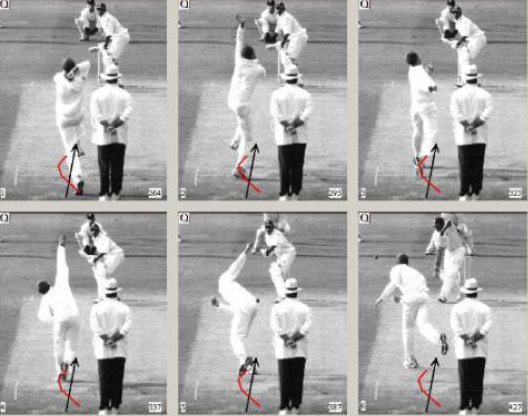
Figure above shows is a six-image sequence of a bowler jumping outwards towards 2nd slip during the pre-delivery take off, BFC and FFC. The red line follows the path of the feet during the action. The black arrow shows the target line. The two are totally different. Every effort should be made to get the run-up on a straight line and thus allow good alignment to happen naturally. The pre-delivery stride, BFC, FFC and the first stride in the follow through should be in a straight line, AIMING TOWARDS THE TARGET – follow the black arrow not the red line!
Just at the moment of Pre-delivery take off, notice how close the bowler is close to the stumps. However on BFC the bowler has jumped across to the middle of the crease. At FFC the bowler is even wider on the crease (Frame 68). All the bowler’s momentum is going
towards 3rd slip! (RH Batsmen)
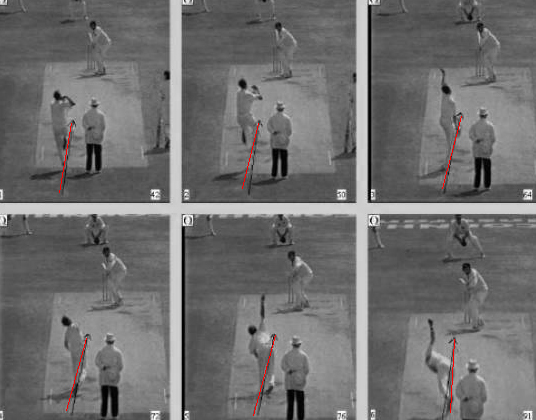
Alan Donald demonstrating good alignment during the bowling action. The same red and black lines are used to highlight the differences between figure 13 and Figure 14. The bowler must maintain their momentum towards the batsman until first foot follow through has landed (Right Foot in the case of a right handed bowler) – then ensure that the next step is away from the danger area.
So next time you see Shankar Subramaium at YPL , you know that these are the reasons he bowlers quicker and if your action is rectified so can YOU!!
Cheer!!


















